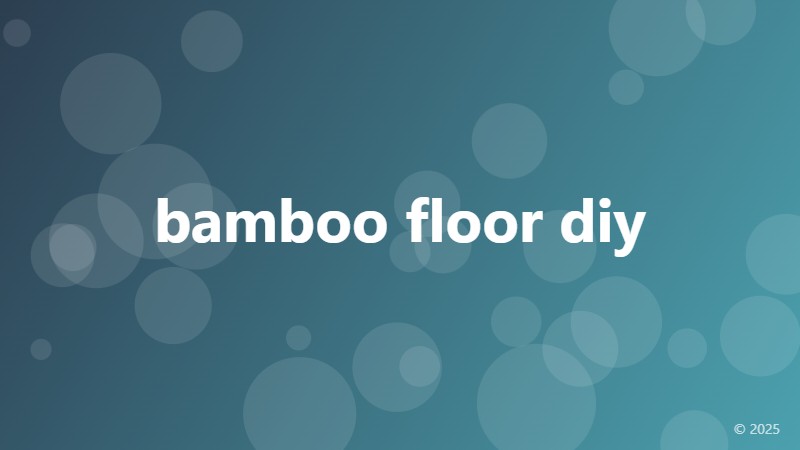bamboo floor diy

Why Choose Bamboo Flooring for Your DIY Project?
Bamboo flooring has gained popularity in recent years, and for good reason. This eco-friendly, sustainable, and durable material is an excellent choice for homeowners looking to upgrade their flooring without breaking the bank. With its unique aesthetic appeal and numerous benefits, bamboo flooring is an excellent option for a DIY project.
Benefits of Bamboo Flooring
Bamboo flooring offers several advantages over traditional hardwood flooring. For one, it's an environmentally friendly option, as bamboo is a fast-growing grass that can be harvested in as little as three to five years, compared to traditional hardwoods which can take decades to mature. This makes bamboo flooring an excellent choice for eco-conscious homeowners.
In addition to its eco-friendly credentials, bamboo flooring is also incredibly durable and resistant to scratches and dents. It's also resistant to moisture, making it an excellent option for kitchens, bathrooms, and other areas prone to humidity.
Preparing for Your Bamboo Flooring DIY Project
Before you start your bamboo flooring DIY project, it's essential to prepare your subfloor. Ensure that it's level, clean, and dry. Remove any old flooring, and check for any cracks or unevenness. You may need to apply a self-leveling compound to create a smooth surface.
Next, calculate the number of bamboo flooring planks you'll need. Measure the length and width of your room, and add 10% to account for cuts and waste. It's also a good idea to purchase a few extra planks in case of mistakes or damage during installation.
Installing Bamboo Flooring: A Step-by-Step Guide
Installing bamboo flooring is relatively straightforward, but it does require some patience and attention to detail. Here's a step-by-step guide to help you get started:
1. Begin by laying down a layer of underlayment material, such as foam or cork. This will provide a smooth surface for your bamboo flooring and help reduce noise.
2. Start by installing the first row of bamboo flooring planks along the longest wall in the room. Use a chalk line to mark the location of the first plank, and ensure it's aligned with the wall.
3. Install subsequent rows of planks, staggering the joints between each row to create a natural, random pattern.
4. Use a tapping block and a hammer to tap each plank into place, ensuring a snug fit between each plank.
5. Cut the final plank to fit around any obstructions, such as heating vents or doorways.
Tips and Tricks for a Successful Bamboo Flooring DIY Project
To ensure a successful bamboo flooring DIY project, follow these tips and tricks:
- Work in small sections to maintain even spacing between planks.
- Use a laser level to ensure accurate alignment and spacing.
- Use a pull bar to remove any excess adhesive or debris from between planks.
- Apply a finish, such as a polyurethane or oil-based sealant, to protect your bamboo flooring and enhance its appearance.
By following these steps and tips, you can create a beautiful, functional, and eco-friendly bamboo flooring that will last for years to come. So why not give it a try? With a little patience and practice, you can achieve professional-looking results without breaking the bank.